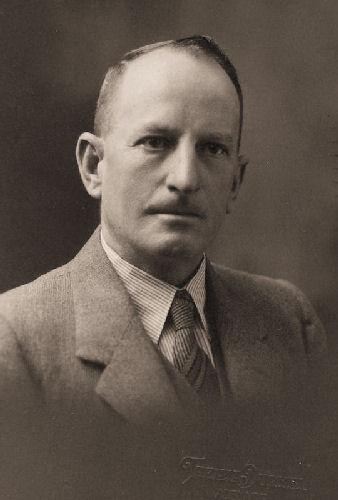Ernest Harry Edmonds 1883 - 1962
Farm section 49 Hundred of Pygery County Le Hunte South Australia 1915 - 1944
Written by Ray F Edmonds September 1984
About 1881 my paternal grandparents John & Mary Edmonds and their three daughters moved from South Australia to Robertson Brothers' Comongin Station in South West Queensland where the Bowman pastoral family made John manager. It was on this station on 28th August 1883 that their last child and only son Ernest Harry was born.

About mid 1884 the family moved back to South Australia to take up the position of station manager at Minburra sheep station North East of Orroroo South Australia. The Bowman Brothers also owned this station and John had previously worked there in his single days and first six or so years of his married life as a bookkeeper. By 1888 John's health had collapsed and the family moved back to live in North Adelaide
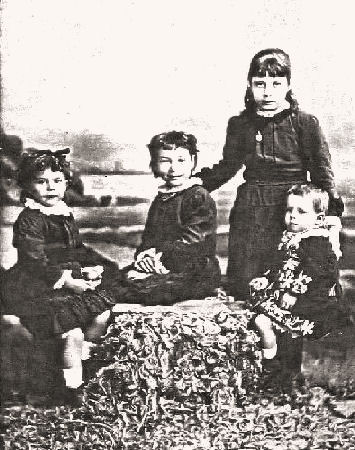
Tragedy struck the family on January 2nd 1889, when John died, aged only 42 years, leaving a widow, three daughters (14 - 6 ½ years) and Ernest Harry, now 5 years old, to mourn his passing. Mary and her mother, who was also by now a widow, battled on and reared the family. As the years went by the daughters married and moved out and young Harry had finished school and had a job with the printing firm of Scrymgours.
At this time, May 4th 1899, Mary died, only 47 years old. As the girls were married and had left home, the family was finished as a group. From then on Harry had to make his own way in the world. His grandmother, Mary's mother, moved to Western Australia with a relative and is buried at Albany in that state. Harry was, in his young days, of light build and apparently his school nickname was Skeet. I presume he wasn't much bigger than a mosquito.
The following few paragraphs are an extraction from the book written by Frank Masters, "Saga of Wangarleednie", as my knowledge of the next few years is vague.
"John Mitchell, a saddler of Kadina, having taken an area to exploit installed W Leslie, a dam sinker from the north, on shares. While on the station of Bowman Brothers, Minburra, he became acquainted with a young lad, Ernest Harry Edmonds, whom he told if ever he was at a "loose end" he would be glad to have him here.
Young Edmonds was orphaned early by the loss of his father in the first instance, soon followed by the decease of his mother, and finding himself in a printing establishment with a salary less than he could live on rather than burden his sisters, went to Bowman Brothers, where even if the salary was small he had that above his living.
Edmonds burst city bondage for outback freedom in open spaces, where he found adventure and the prospect of getting somewhere. It was in his blood, for his pioneer grandfather before him thought nothing of walking 20 miles to Adelaide to win his bride. Environment can never trammel such men, and Harry, remembering Leslie's suggestion came across to Mitchellville in 1902, to his friend pioneering this part. For eight years he took anything that offered here from farming to wheat tallying and sundry trips once more to the stations droving and shearing - all were grist to his mill to found a home for himself. For sometime it had shimmered in his imagination." (End of Quote)
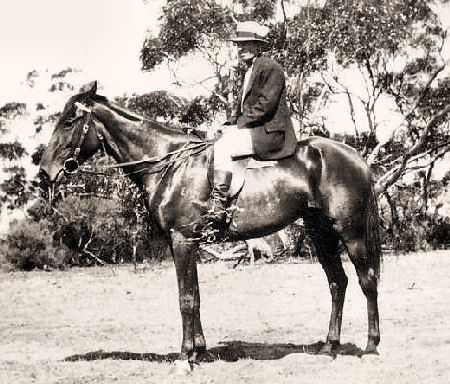
This life enabled him to be among and use horses and he developed ability with them both as a teamster and also a jockey, his lightweight being to his advantage in the latter. I don't think he was a rough rider but he had a way with horses and he liked and respected them and "broke in" many.
He arrived in the Cowell area in the very early 1900. He was in his late teens. He worked in shops, on farms and as "tally clerk" at the wheat yards and goods sheds. Cowell, at the time and several years later, was a port for boats and ketches bringing goods of all kinds to the area from and to Wallaroo.
Although there were no motorcars around in those days the people still moved around their local areas quite a lot. Modes of travel being buggies, sulkies, carts, drays, horseback, pushbikes, peddle assisted motorbikes (no gears, belt drive) and even on foot, ten mile or so being considered a reasonable walking distance if no other means of transport available. Football, cricket, some tennis and athletic sports were popular. About this time Harry was trainer/manager for a couple of local (Cowell) athletes, travelling to various sports meetings on Eyre Peninsula, with considerable success.
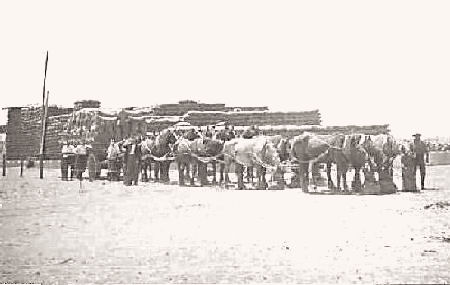
It was while acting as coach driver and general caretaker of the coach and horses for a party of government officials and surveyors on a mission from Port Lincoln up the coast through Streaky Bay area to out north of Wirrulla that Harry had his first long distance view of all the Poochera, Minnipa Hill and Mt Wudinna country. At that time (early 1900) all the area in view in that direction was scrub with numerous small grassy plains. The officials told the young Harry that in the near future all that area viewed would be "opened up" and become available for farming. It was planned to build a railway line up through the centre of Eyre Peninsula from Port Lincoln to Murat Bay or further and to develop water catchment tanks and dams at any useful granite outcrop sites or areas with potential "run off" in event of heavy rain. This was exciting news for a young fellow with ambitions of having a farm of his own.
Early in 1910, Harry married Mabel Jane Haines, a sister to W. M. (Mart) Haines who was pioneering in the Mitchelville district at that time. The young couple undertook share farming with W. F. Franklin in the Mitchelville area for 4 years. Mainly the seasons were good except for some rust in the crop, and the couple were gradually getting started in life. 1914 was one of South Australia's (perhaps all Australia's) worst ever drought, it was a serious handicap to the young and also not so young, trying to get established in farming. In the 1915 season the couple, and by now two sons, moved to a share farming position in the Cleve area.
By this time the railway line had been built from Pt Lincoln to Minnipa, later to Thevenard (Murat Bay) and land was available for settlement in the Kyancutta, Wudinna, Yaninee, and Minnipa areas and elsewhere.

The Wudinna-Yaninee area became open for allotment in 1914-15. A party including Harry, his brother-in-law W. M. Haines, W. F. Whyte (I think perhaps dad and mum was share farming with them) and A. F. (Art) Franklin came over to look the prospects over. They travelled per Model T Ford car owned by W. M. Haines. This car was, I'm told, the first car in the Cowell area and was the first to make a trip to the Wudinna-Yaninee area. They travelled mostly by "bush track", some very sandy, from Mitchelville, Cowell, Cleve, Darkes Peak, Waddikee Rocks, Mt Wudinna to the area, in this case, to the Hundreds of Pygery and Yaninee.
It was a triumph for the car and driver, the only serious mishap being that they hit a snag (cut off tree) and bent the front axle. The axle was removed and a fire made to heat the steel axle and it was straightened by hitting it with hammers and axes, which of course, they carried for such emergencies. Mart Haines was a man who could make mechanical things work and could improvise on the spot with only very basic material. This trip was a prelude to greater triumph for the adventurous and energetic Harry. (Ditto Art Franklin, who later settled, pioneered a farm and reared a family at Yaninee).
On February 5th 1915, Harry was allotted land, being section 49 Hd of Pygery. Over the years he and his wife and family, with a little hired labour, hewed the farm and home out of the wilderness of scrub. This had been their ambition for a number of years. Harry arrived to reside on the property in early 1916. He travelled across from Cleve, where he had been share farming, by wagon and four horses. Two horses (one in foal) he owned and two were borrowed from friends.
Prior to arrival he had a "government" shed erected on the block. These sheds were available through the Lands Department on long, low interest terms and were fairly common in the area. They were 60ft x 30ft skillion roof (roof only no sides) wood and galvanised iron with two 2500 gallon galvanised iron tank at each end. As the average rainfall was supposed to be 12+ inches per year on average that size roof would fill the four tanks (plus) per year. This gave the settler some reserve of domestic and stock water.

As the area was surveyed, and prior to allotment, the government put down a series of tanks (concrete lined and galvanised iron roof) and earth dams. These were mostly adjacent to granite outcrops. Yumburra (Pinbong) tank and dam, Pygery Rocks, Mt Wudinna, Poldinna rock and also where decent ground runoff could be obtained. Yaninee, Masonary, La Polda, Bryant's Plains tanks. These were all more or less in our local area. Some still hold water today but mostly they have gone into disrepair. In the early years of the area, water was at times a scarce and precious commodity as there was no usable underground water supply in the immediate area; a small soak (brackish stock, emergency water only) at Agars Lake (Pinbong), a soak (also somewhat brackish) on the Bramfield - Buckleboo stock route at Kappakoola and a small well (private) at Mt Wudinna. If there were others I don't know of them. A tank at Peela rocks, also on the stock route was another somewhat distant (from our farm) supply.
Harry put down a well (bore hole) in the early-mid twenty's on section 49 Hd Pygery but, although he struck water of reasonable supply at 80ft, it was saltier than the sea and useless for any purpose. Later Dad and also many other settlers in the area, put down private earth dams, and given heavy rain to create run off, were a valuable asset. Later the "Tod scheme" was put through the area giving us a reticulated water supply.

On arrival at the property in early 1916, Dad's first job was to build some sort of accommodation under the government shed. He was fortunate that there were a considerable number of native pines close by and he built two rooms of pine (barked) uprights covered with clay mud and "cocky chaff" mixture plastered on the outside and inside with a trowel. Some lime was added to some of the pug to form a kind of mortar. When dry, the smoothed-off wall was given a coat or two of lime whitewash. It was a yearly job patching where pieces of mortar fell out during the year. Numerous early settlers burned their own lime, as there was plenty of limestone in the area.
Dad had brought some basic items of furniture, and pots and pans; also a little seed wheat and some basic tools such as axes, pick and shovel, etc. Some beds were made from wheat bags stretched over native timber and a mattress bag was filled with "cocky chaff". Packing boxes were used extensively to make cupboards and seats.
After getting the rooms finished he was ready for the family to move in. Mum stayed behind in Cowell, as I was due to be born any day. It happened on April 12, 1916. Brothers Jack, 5 years old and Ralph 4 years, came over accompanied by an auntie. They were probably taken by Mart Haines to Terre (Lock) siding and sent up in the train.
When they were settled in Dad and a lad he had with him, made a trip by cart to Cleve, going on to Cowell to see his wife and new son. On the return trip, via Darkes Peake, (the usual way then), he had a load of stores and goods. Also included were our first cow, "Buttercup", (she walked all the way behind the cart), two pigs (one pregnant) and some fowls in cages hanging on the side and underneath the cart. The trip probably took at least a week as the stock would need feed and water and horse and cow probably "hobbled out" on a grassy patch at night for a few hours. Much travelling in those days was done at night, especially on a reasonably clear track and if the weather was hot and there was a moon to give some light.

The farm's first crop would have been planted about this time. It was 1916 and apparently finished quite a good season. There was a thirty-acre plain near the shed site and Dad ploughed the ground, broadcast the seed and probably a little superphosphate by hand. He then cut down a fairly large mallee and dragged it over the land a couple of times, with two horses, as a harrow. The resultant crop was by all accounts quite good. He reaped it with two or three horses in a stripper he had bought at Cleve. The stripper is still here, fully restored, in working order. A bit later, used with disc drills for sowing crops, mallee boughs were hooked behind, making effective cover harrows and were used a lot.
About the end of May 1916 Mum would have arrived, with me as a baby, to take up residence, probably travelling by train.
The family was growing up. Jack was 6 years old and schooling was a must. There were some other children in the area (we had three neighbouring families within one and a half miles) but Jack was older. Arrangements were made for him to board at Yaninee and attend a school opened there in the local hall. He attended there for about a year or so. Yaninee was our siding in those days, Pygery being set up later.
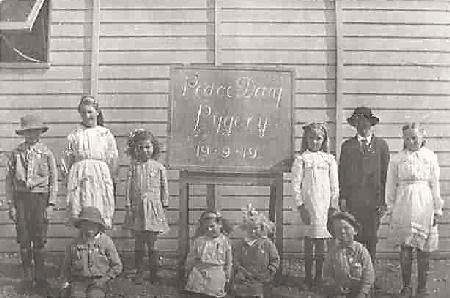
Ralph came of school age, as did other children in the area, and agitation began to have a school opened in the local district. Eventually a school was opened in May 1919 and called Pygery School, later changed to Pinbong when a school was opened at Pygery Siding. The school needed a teacher and a teacher need a place to board. Dad and Mum (active school committee members like most of the other parents) undertook to board the teacher. Dad extended the two rooms to three by adding on a room. This room had one wall of stone and lime mortar built between boards, one wall jarrah palings lined with whitewashed bags, the other wall made from some paling (not enough), some bag and some tin also lined. It had a lime-ash rammed mortar floor (a bit like concrete). The local schoolteachers boarded with us from then until the school closed in 1942, thirteen teachers in all. One, for a short time, boarded with a neighbour who was their sister and brother-in-law.

Later, another room was added, the "boys' room", made of petrol tins and some galvanised iron lined with whitewashed bag. The "man's" room was a tent in the shed. If we had visitors, beds were made up on the couch and floor and sometimes the boys had to move out to a tent or sleep under the verandah.
We had a cellar dug and lined just under or out from the verandah and in there was kept the separator, cream, meat, preserves, jam, etc. and also surplus groceries if we got an order from Adelaide. Mostly, we supported the local stores as it was considered that they were also helping to develop the district. It was a big day or two when a steer or large pig was slaughtered and dressed on the farm. In the case of a large beast, a certain amount was "hawked" among the neighbours. It was weighed and could either be bought for cash or returned later or next year when they had a butchering day.
There was no refrigeration and any meat that couldn't be used fresh had to be salted down. Most people had a box or a barrel for this purpose. It seemed to us kids that it was extra good living after a "kill" as we had pasties, sausage rolls, and etc. in abundance. We were lucky we had a Mum who was a good and versatile cook. Like all others of the era she made all her own bread and cakes, and nearly all our clothes. She could make, and appeared to enjoy making, something useful from a heap of what appeared to be rags; a bedspread, a dress or a shirt. Nothing wasted was the rule of the house.

In the early days there were virtually no roads, only bush tracks. The early settlers were paid to clear sections of road that had been surveyed. Dad cleared part of the road that went from Barns' (now Water's) corner to Wudinna. There were numerous short cuts through the scrub as there were no fences in the first few years of settlement. A mile saved in a horse and cart on a bush track could mean a saving of half an hours' travelling. Brother Jack's earliest memory of the farm is coming home from Yaninee, in the cart, in the pitch-black dark of night, with Dad. The track was a reasonable bush track but they could not find where to leave it to get to our shed (house). Dad was walking up and down the track looking for the "turn-in". This was in 1916.
The farm was worked by horse team for the first eleven years, having fifteen or sixteen horses at one time. In the early 1920's Dad purchased a team of bullocks, mainly to be used for rolling scrub. He used them for that purpose on his own farm and also did some contract rolling with them on other farms in the area. He used them sometimes to cart water, mainly for themselves and the cows and pigs. The horse team was often, in the slack time of the year after seeding, let go "out back" to fend for themselves. As the weather warmed up they would come home themselves for water. "Out back" there were a number of grassy plains and grass in the burnt scrub.
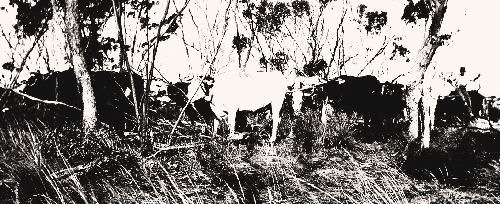
A lot of scrub clearing fires got away in the early days. For a year or two after the scrub was burnt a considerable amount of spear grass grew. This was first class horse and cattle feed and also good sheep feed until it set seed, when the seed became a problem in the wool and could work its way through the skin.
Water, in a prolonged dry period, was a problem. If the water in the shed tanks went below a certain level, to be kept for domestic use, and the private dam was dry, water carting had to be done. First the closest Government tank and dam, in our case Pinbong, then if a reasonable supply left the next nearest and so on. If all failed, the water was carted by train from further down the track and carted to the farm by the team. Sometimes one tank or dam could be dry but because of a thunderstorm another one not far away could have an ample supply. It was pretty well an unwritten law that you didn't cart from someone else' area if they were short, too.
There were special domestic water restrictions on the farm during dry periods. Saturday afternoon or night was time for the weekly bath. The bath was an oval, galvanised iron tub, also used for clothes washing with a scrubbing board. The tub was usually placed in the kitchen by the fire in the winter with a bag or two for mats. Mum had four kids and the cleanest had first bath and the dirtiest went last, all in the same water, with a bit of hot water added, for each one, for comfort. After bathing was over the water was used for washing the clothes and when cold, was put on the garden. Nothing wasted.

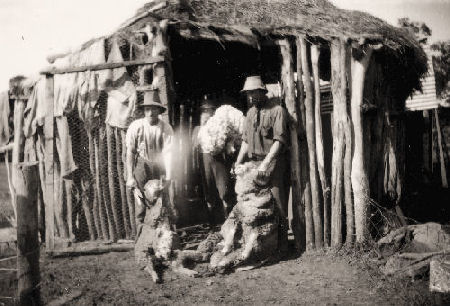

People, animals, birds and plants all need water so, especially in the dry part of the year, it was a closely guarded commodity. Despite this we, and most others, managed to grow some vegetables and flowers. If we happened to have good thunderstorms and runoff water lay in the flats in the paddocks we grew good melons, both pie and watermelons, in these patches. Could be lucky and grow turnips, peas, etc. in the paddock if the weather was right.
About 1925 Dad decided to quit the bullock team and get some sheep. He sold some bullocks to the local butcher. Although working animals, the bullocks had had a considerable holiday "out back" and were in prime condition. The money was spent getting eighty aged ewes and one ram.
At this time there were no sheep proof fences and it was Ralph's and my job, after school, to round up the sheep and yard them for the night. We got to recognise several of the sheep by their facial expressions and other characteristics and gave them names. We became personal friends or enemies, depending on their behaviour.
The proceeds from the wool supplied finance to buy fencing wire to fence the property into eight sheep-proof paddocks. The posts for fencing in that era, and much later, were cut out of the scrub on the property, mostly ti-tree with some native pine and cong mallee. A lot of the original posts, cut on the property, are still standing after seventy years. Sheep became an important contributor to the farm income. The first wool clip was three foot-pressed bales and a couple of bags of oddments. Mutton became readily available, but was not to be wasted as any surplus sheep were quickly sold within the district, in most years.
In the mid 920's the Tod River water scheme became a reality and the farm was connected to the scheme in 1927. It was the making of the country as it gave more stability and allowed more stock, especially sheep, to be carried. Dad used to say that it was one charge he didn't mind paying. Of course, the scheme never paid its own way and never will.
1926 had been a reasonably good season and Dad bought his first car, a Ford Model T, in 1926 at a cost of 169 pounds. A year later Ford brought out a new model for 156 pounds, the cheapest they ever got.
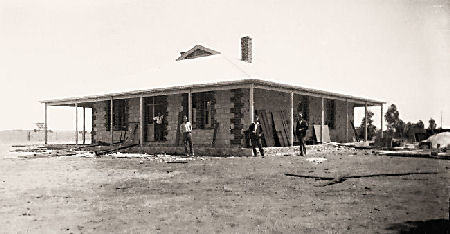
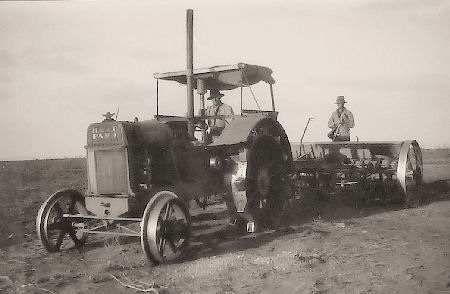
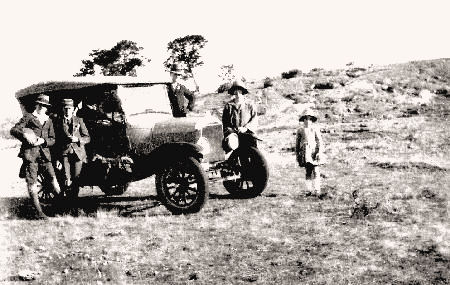
1927 was an important year on the farm. The Tod water was laid on and Dad let a contract to have a new house built. It was built of limestone raised from the farm by Jack and Ralph and carted by horse and dray to the site. It was heavy and hard work. Some home burned lime was used and local farm sand. The front wall built with "Duck Ponds" stone, brought by train from that siding, near Port Lincoln. It is a softer stone and much easier to trim to shape than the local limestone.
Dad bought his first and only new tractor and "combine" in 1927-28. A combine was a fairly new innovation that allowed the farmer to cultivate the soil, sow the seed and spread the fertilizer all in the one operation.
He had a small auction sale, selling off some surplus plant and horses. 1928 was a poor season and the start of a worldwide depression. Conditions became very severe and a lot of settlers had to eventually give up their properties. Wheat prices were below the cost of production and money was very hard to come by.
Other items of machinery had been bought over the preceding ten years to 1926. Included were a winnower and transportable engine, plough, cultivator, disc drill, header, wagon, binder and a chaff cutter with "horse-works". With the horse-works the strength of the horse was converted through a set of bevel gears to a pulley and belt to drive the chaff cutter blades. The horse walked round in a circle, at about seven kilometres per hour, attached by chains to a beam which was bolted to a huge bevel gear about three feet across. The bevel gear drove a pinion of 100-150 mm diameter. This pinion was attached to a spindle, which extended, below ground level, to a point outside the circle the horses were travelling. On the end of this shaft was a bearing and a pulley from which a driving belt ran to the machine being used, in our case, the chaff cutter which was used to convert hay into chaff for stock feed.
There had been a number of buildings erected. Stables, harness shed, implement shed, shed for seed and horse feed, milking shed and pig sties. These were all built with native timber, cut on the farm, and roofed with broom bush or ti-tree and covered with straw. Another machine we had was a straw rake, also harrows, buggy, tip-dray and grain grinder.
During the first ten to twelve years there was some worries with smut in the wheat crops and the seed had to be pickled. Although there were some contraptions to do the job we did it in an old trough with a shovel. The wheat, a couple of bushels at a time, was put in and a jam tin or two of water-based pickle (bluestone, later formalin) was sprinkled on and then was the mixed with a shovel. It was called wet pickle because, when finished, the grain was wet and had to be sown next day in ground wet enough for it to germinate straight away.
The 1930's were hard years with all prices low, family members got a little pocket money (if they were lucky). Farm labour was five shillings to thirty shillings a week, plus keep (board and lodgings), depending on their ability. Unemployment was high, and some people, especially family members, worked just for their keep.
The Second World War started in 1939 and a lot of people moved to the armed forces, munition factories, etc. The population in the district never built up again and a lot of sections of land were unoccupied and left idle. To make the business of farming more viable the holding sizes were increased by adding on one or two adjoining sections. The trend continues today with whole farms being amalgamated. This farm now consists of section 49 (original), section 48, section 30 and the old Pinbong School three-acre block, section 131. This was originally the northwest corner of section 30. It was made available for the building of the school by the then owner, J.F. Heylen. The farm now has an over-all area of 1611 hectares (aprox. 4,000 acres).
Dad was always socially and community-minded and was involved in most activities in the area. Quite often he was chairman or secretary of the various committees.
Yaninee was our railway siding in those first few years, so it was natural that he was involved in the early progress of that township. In the first instance the farmers would congregate at the railway siding while waiting for the train. It was often quite late, sometimes several hours, so it would be natural that discussion went on and probably a progress association or similar group would have been formed.
There was nothing at the siding except a waiting room, which was nothing more than a small tin shed, about two and a half metres square, built when the railway line was constructed. It had a wooden floor, a small wooden seat along one wall and a solid wooden locker for railway cartnotes, etc. This was where passengers would wait for the train and where goods and mailbags were left if there were no one there when the train arrived. In the first year or two, the farmers met the train, and sorted their own goods and mail. Early in the history of Yaninee a small store and unofficial post office was opened on the corner that leads to the site of the present oval.
It was about 1918 that a wood and iron building was erected, on the site of the present hall, as a town hall, school and general meeting place. It was erected by voluntary labour and the first dance was held there before it was finished, with just the walls and floor. This was where the first school in the area was opened. Some private schooling had been given to some children before this, probably in the shade of trees or tent.
To raise funds and to provide some social life, athletic sports, horse-racing meetings and a little later, football games were held. The race- course was on the edge of a swamp opposite Mitchell's gate. Wally Mitchell was one of the local jockeys, along with Dad. Dad often had show or race horses to train; he had a temporary hurdles course erected, at times, near our house on the plain.
Any sports meetings, race meetings, cricket (usually all picnic type meetings) and football were followed by tea and a dance. The dance, on occasions, would go on until daylight or near. They would then either have supper or breakfast, depending upon the time, then go home in the moonlight or daylight, as the case may be. My memories include sleeping (supposed to be) under the seats at Yaninee Hall, while a dance was in progress and coming home later, bedded down on the bottom of the buggy. The buggy was a two-seat model, seating for four to five people, and was pulled by two horses. It had no hood and only low sides and the only way to keep reasonably comfortable on winter nights was to wrap up in plenty of rugs.

In 1924 Dad was secretary of the "Central Eyre Peninsula Medical Club". To my knowledge, this club was district wide and anybody could become a financial member. A committee was elected with a member or two from each district. It was through this group, and the District Council, when it was formed, that a doctor eventually came to the district, and the Wudinna Hospital was built.
In the very early days, up to the early twenties the nearest doctor was at Cowell, Port Lincoln or Cummins. My parents had a "doctor's" book, which listed most complaints and their symptoms. On making a decision on what the trouble possibly was, a treatment would be listed in the book. They also had a little cupboard with various pills and ointments and some bandages, together with tweezers, thermometer, etc. It was called homeopathic medicine. Luckily we were a fairly healthy group, but still had things like whooping cough, mumps, measles, boils, etc.
The Bedfords at Kyancutta ran a small "hospital", but most confinements were either at home or the expectant mother went away before the birth of the child. My sister, Gwen, was born at Cummins, where there was a doctor and a small hospital. That was in December 1919, and Mum travelled there by train. There were two ladies living at Yaninee who later attended and cared for ladies in confinement in the patient's own home. Nurse Leamark was the name and she attended to a number of women.
The local district had an agricultural bureau (most districts had one) and dad was a very active member for a considerable time until he relinquished farming and went into politics. He had numerous trial plots here on behalf of the Agricultural department; wheat and oat variety tests and a little later clover (medic) trial plots. The medic trials proved very important. There were a number of other trials throughout the district.
We had been through a period of low grain and other prices and to help farm viability, production of the land had to be increased. Medics put nitrogen into the soil and also produce excellent grazing. The result was what we see today with most farms having a lot of "clover".
There was a crop (wheat) competition (annual) held through the Agricultural Bureau. Dad was involved in this for several years, winning on at least one occasion. The crop concerned was not always the best in the district, but the best of those who took part. A lot of farmers didn't take part.
The District Council of Minnipa, later changed to Le Hunte District Council was formed in the 1920's. Dad became very actively engaged in this organization serving some seventeen years, eleven of which he was chairman.
This position made him chairman of the board of management of the Wudinna hospital. The position of chairman was very time and thought consuming. Many days and a lot of nights were taken up on this honorary position. Many days sometimes up to a week at a time dad would be away from the farm. It necessitated much travelling on Eyre Peninsula and to Adelaide. (Some of these costs would have been refunded, I think)
The erection of telephone lines through out the district made communication much better and saved much travelling.
Dad relinquished his district council position in 1944, and was elected as a member of the state Legislative Council in that year. He served in that position for eighteen continuous years. On retirement from the Le Hunte District Council, dad was presented with a printed address. This is a copy of the wording and signatures of members past and present at the time.
"We the members and past members of the District Council of Le Hunte and the board of management of the Central Eyre Peninsular Hospital Inc. wish to record our appreciation of the valued service rendered by you as a member of the District Council for seventeen years during which period you served office as chairman for eleven years and also as chairman of the board of management of the hospital.
The satisfactory state of affairs of the district we trust will be lasting memorial of your able administration and keen interest in public connected with the district.
Your election to the Legislative Council in the state parliament is indicative of the high esteem in which you are held by the people of the district.
We have every confidence in you in your extended sphere to the public service to the State of South Australia and desire to extend to you our heartiest congratulations and best wishes for the future.
D. L. Sampson R. Bedford
John Mc Beth W. J. Black
H. W. Broad E. J. Oswald
G. H. Simpson W. J. Bedford
J. G. Christian H. H. Tyler
L. W. Parker H. Knight
P. W. Symonds G. Williams
J. L Whitehead M. A. Trudinger MBBS
H. A. Hampel A. W. Christian MP
H. Mc Kenna J. L. Mc Mahon"
My parents were solid supporters of the Wudinna show society with up to a hundred entries in one year. Horses, sheep, cooking, vegetables, flowers, grain, etc.; I can remember leaving home before daylight with Dad with a dray load of entries and several horses. The rest of the family come in the buggy a little later. It was a big day of the year, socially.
In the latter 30's Dad had a homemade set of drums and played them at local and district balls and dances. Ralph Farrant, a young lad in the bank at Minnipa was pianist.
The years went by. Jack married and went out on his own. Ralph started full time with the Le Hunte council as a truck driver. He worked up to more responsible positions and eventually made a career in Engineering and Water Supply department.
Dad and I, with some casual help at times, worked the farm. As Dad's public responsibilities increased I took on more of the responsibility for farm work and management.
In 1944 dad was elected to the Legilative Council of South Australia. During that year my parents and sister went to live in Wudinna. I, now married with a family, moved into the section 48 to live in the old home working the farm on a share basis.
In 1946 our mother died after a long illness and is buried in the Wudinna Cemetery. Dad, now a member of the legislative council representing the northern and western areas of South Australia, needed a base in Adelaide to be near his headquarters, Parliament House. He sold up his household effects at Wudinna and went to Adelaide to live. At first he boarded with a private family but a little later purchased a house and lived at Port Noarlunga, SA.
In early 1949 dad sold his farming interests to me and had the property transferred to me. After a few yeas he remarried and bought a house and lived in Brooklyn Park, SA.
It was here in April 1962 a few months after having finished his term as MLC (18 years) that he had a stroke and died a few hours later in hospital. He is buried in Centennial Park cemetery in Adelaide.
Thus ended the life of one who had had a full and useful life and who, with his first wife, was one of the Yaninee-Wudinna districts early pioneers.
E. H. Edmonds: activities other than farming after residing at Pygery.
District Council of Le Hunte member 17 years
District Council of Le Hunte Chairman 11 years
Wudinna Hospital board of management Chairman
Central Eyre Pennisula Medical Club Secretary
Legislative Council of SA 18 years
Parliamentary New Industries Committee Chairman
Partly responsible for having the tuna and prawning industries established at Port Lincoln by having Haldane Bros of Port Fairy, Victoria build boat and move to Port Lincoln.
Justice of the Peace From 1928
Eyre Peninsula Local Government Association chairman
Agricultural Bureau (local) chairman
